Wednesday, April 12, 2006
Santa Cruz Clam Chowder Cook Off 2006
Ordering New England Style Clam Chowder at a restaurant is an irresistible temptation for me. I always have to try it because everyone makes it a little different. My most common complaint is the lack of clams in many restaurant clam chowders, so I prepare my own whenever I have some extra cream on hand. My recipe balances the generous portion of clams with a satisfying amount of potatoes and clam juice to provide a briny flavor to this cream-based chowder. Steamed fresh clams can replace the canned clams if you have time or want to bring this recipe to the next level.
There are countless varieties of clam chowder - the most popular of which are called New England Style and Manhattan Style. The label New England Style has come to mean that the chowder has a cream or dairy base while Manhattan Style refers to a tomato base. A brief Google search reveals that the terms Maine style (heavy cream), Rhode Island style (light cream / soupy), Oregon style (extremely thick), Yorktown style (containing beer or ale), and Southern style (more vegetables and spices with some Worcestershire sauce) are also used - but I have yet to see them served in a restaurant. Of course, some restaurants' New England Style clam chowders seem to fit the description of Oregon or Rhode Island style.
Classic New England Style Clam Chowder begins with salt pork, but since I live in California, I've started with the West Coast classic: bacon (this time in the form of bacon grease). But first, let's take a look at what other ingredients we'll need.
Begin with one pound of diced russet potatoes (about one large potato) and 1/2 cup onion (about 1/2 medium onion). You'll also need a tablespoon of all-purpose flour and two tablespoons of bacon grease.
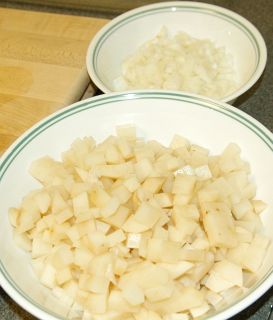
Drain the clams from two 10-ounce cans of clams (preferably canned in water, salt water, or broth - not oil). After draining, both cans should yield about a total of 10 ounces of clam meat. Also, prepare 8 ounces of clam juice. The flavor is better if you use bottled clam juice instead of the liquid the clams are packaged in, but if clam juice is unavailable, reserve 8 ounces of the liquid from the cans.
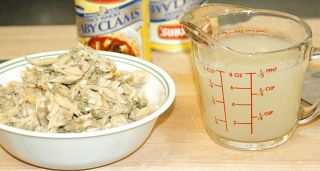
Heat two tablespoons of bacon grease and saute the onions in the hot grease until translucent, but not browned. Bacon grease can be collected and stored after you cook bacon. If you don't have any bacon grease in your refrigerator, go ahead and cook about four slices of bacon in the pan and remove the bacon and any excess bacon grease (remember to store it for future use) before sauteing the onions.
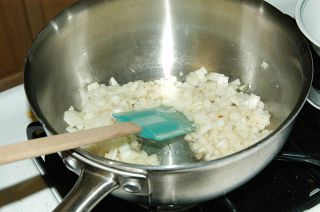
Add the diced potatoes and saute until all the potato has been coated by the fat. Throw in the tablespoon of flour and saute until the potatoes and onions have been coated.
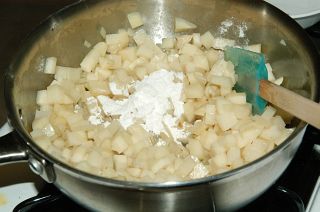
Pour in the cup of clam juice and bring to a boil while stirring. Once the mixture comes to a boil, reduce the heat so it just simmers with the lid on. Cook with the lid on for 20 minutes or until the potatoes are tender.
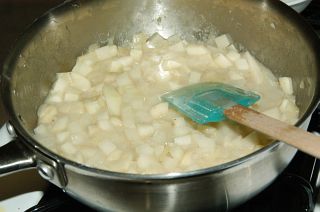
Prepare a mixture of one cup whole milk and one cup heavy cream. Half-and-half will also work as long as it's on the creamier side - if not, augmentation with some heavy cream may be necessary. The amount of fat is important for the texture of the chowder. Using only milk will result in a slightly thickened (due to the potato starch) watery consistency. Using only heavy cream will result in a really smooth, but much too rich chowder. The milk and cream mixture results in a cream fat concentration around 20%, producing what I think is the perfect consistency when served hot or warm. Using combinations of milk and cream to achieve this fat ratio helps us get to our desired consistency target. For example, some light whipping cream (about 18-30% fat content) has a fat content as low as 18%, so using straight light whipping cream of this type will provide us the desired amount of fat.
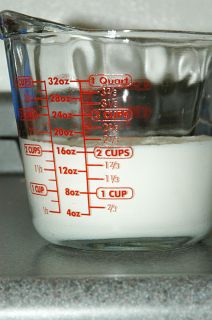
Once the potato, onion, and clam juice mixture has simmered for 20 minutes, stir to redistribute the solids.
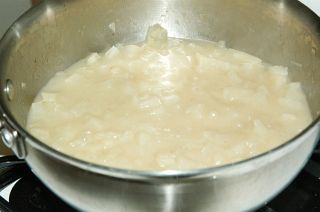
Add the drained clams, milk, and cream.

Stir and heat through until hot, but not boiling. (Boiling may cause some of the milks solids to clump - but with 20% fat concentration this is less of a problem than if we were using straight milk. At around 30% or more fat, there is enough fat to prevent the clumping of the milk solids even while boiling.) While heating, this is right time to season with salt and pepper. Add salt a pinch at a time, stir, and taste. Repeat until you get the desired saltiness. It is important not to forget to add the salt and pepper - even though we have a lot of flavors in the chowder at this point, they will be muted without adding enough salt.
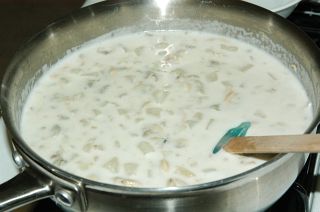
Serve while hot. I like garnishing with a bit of fresh chopped parsley and some bacon pieces.
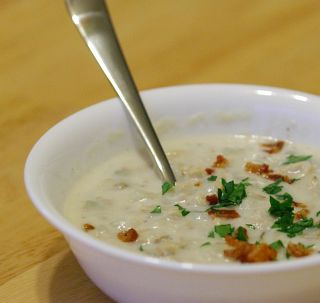
Ordering New England Style Clam Chowder at a restaurant is an irresistible temptation for me. I always have to try it because everyone makes it a little different. My most common complaint is the lack of clams in many restaurant clam chowders, so I prepare my own whenever I have some extra cream on hand. My recipe balances the generous portion of clams with a satisfying amount of potatoes and clam juice to provide a briny flavor to this cream-based chowder. Steamed fresh clams can replace the canned clams if you have time or want to bring this recipe to the next level.
There are countless varieties of clam chowder - the most popular of which are called New England Style and Manhattan Style. The label New England Style has come to mean that the chowder has a cream or dairy base while Manhattan Style refers to a tomato base. A brief Google search reveals that the terms Maine style (heavy cream), Rhode Island style (light cream / soupy), Oregon style (extremely thick), Yorktown style (containing beer or ale), and Southern style (more vegetables and spices with some Worcestershire sauce) are also used - but I have yet to see them served in a restaurant. Of course, some restaurants' New England Style clam chowders seem to fit the description of Oregon or Rhode Island style.
Classic New England Style Clam Chowder begins with salt pork, but since I live in California, I've started with the West Coast classic: bacon (this time in the form of bacon grease). But first, let's take a look at what other ingredients we'll need.
Begin with one pound of diced russet potatoes (about one large potato) and 1/2 cup onion (about 1/2 medium onion). You'll also need a tablespoon of all-purpose flour and two tablespoons of bacon grease.

Drain the clams from two 10-ounce cans of clams (preferably canned in water, salt water, or broth - not oil). After draining, both cans should yield about a total of 10 ounces of clam meat. Also, prepare 8 ounces of clam juice. The flavor is better if you use bottled clam juice instead of the liquid the clams are packaged in, but if clam juice is unavailable, reserve 8 ounces of the liquid from the cans.

Heat two tablespoons of bacon grease and saute the onions in the hot grease until translucent, but not browned. Bacon grease can be collected and stored after you cook bacon. If you don't have any bacon grease in your refrigerator, go ahead and cook about four slices of bacon in the pan and remove the bacon and any excess bacon grease (remember to store it for future use) before sauteing the onions.

Add the diced potatoes and saute until all the potato has been coated by the fat. Throw in the tablespoon of flour and saute until the potatoes and onions have been coated.

Pour in the cup of clam juice and bring to a boil while stirring. Once the mixture comes to a boil, reduce the heat so it just simmers with the lid on. Cook with the lid on for 20 minutes or until the potatoes are tender.

Prepare a mixture of one cup whole milk and one cup heavy cream. Half-and-half will also work as long as it's on the creamier side - if not, augmentation with some heavy cream may be necessary. The amount of fat is important for the texture of the chowder. Using only milk will result in a slightly thickened (due to the potato starch) watery consistency. Using only heavy cream will result in a really smooth, but much too rich chowder. The milk and cream mixture results in a cream fat concentration around 20%, producing what I think is the perfect consistency when served hot or warm. Using combinations of milk and cream to achieve this fat ratio helps us get to our desired consistency target. For example, some light whipping cream (about 18-30% fat content) has a fat content as low as 18%, so using straight light whipping cream of this type will provide us the desired amount of fat.

Once the potato, onion, and clam juice mixture has simmered for 20 minutes, stir to redistribute the solids.

Add the drained clams, milk, and cream.

Stir and heat through until hot, but not boiling. (Boiling may cause some of the milks solids to clump - but with 20% fat concentration this is less of a problem than if we were using straight milk. At around 30% or more fat, there is enough fat to prevent the clumping of the milk solids even while boiling.) While heating, this is right time to season with salt and pepper. Add salt a pinch at a time, stir, and taste. Repeat until you get the desired saltiness. It is important not to forget to add the salt and pepper - even though we have a lot of flavors in the chowder at this point, they will be muted without adding enough salt.

Serve while hot. I like garnishing with a bit of fresh chopped parsley and some bacon pieces.
